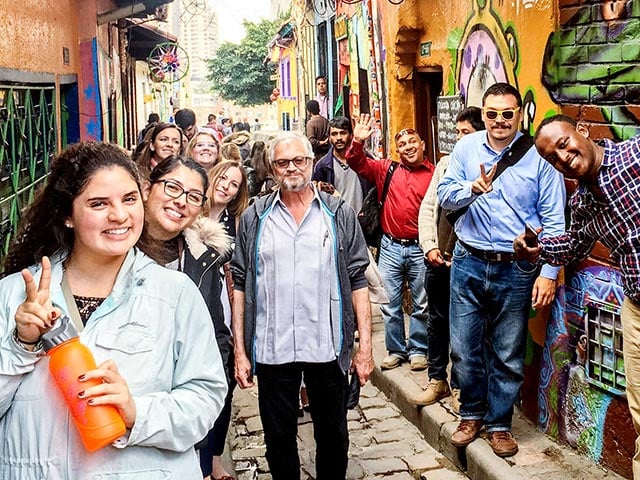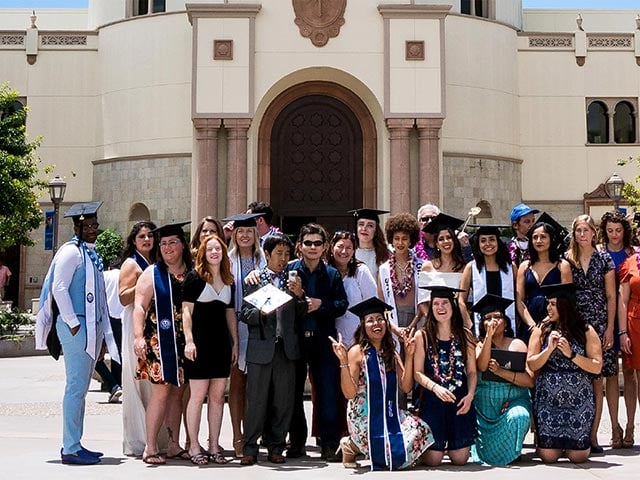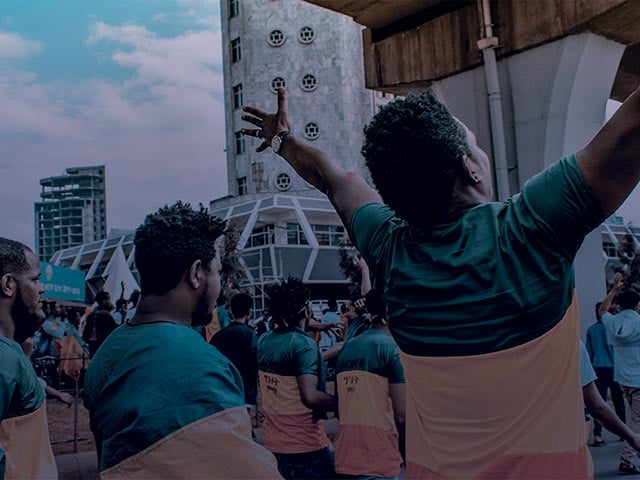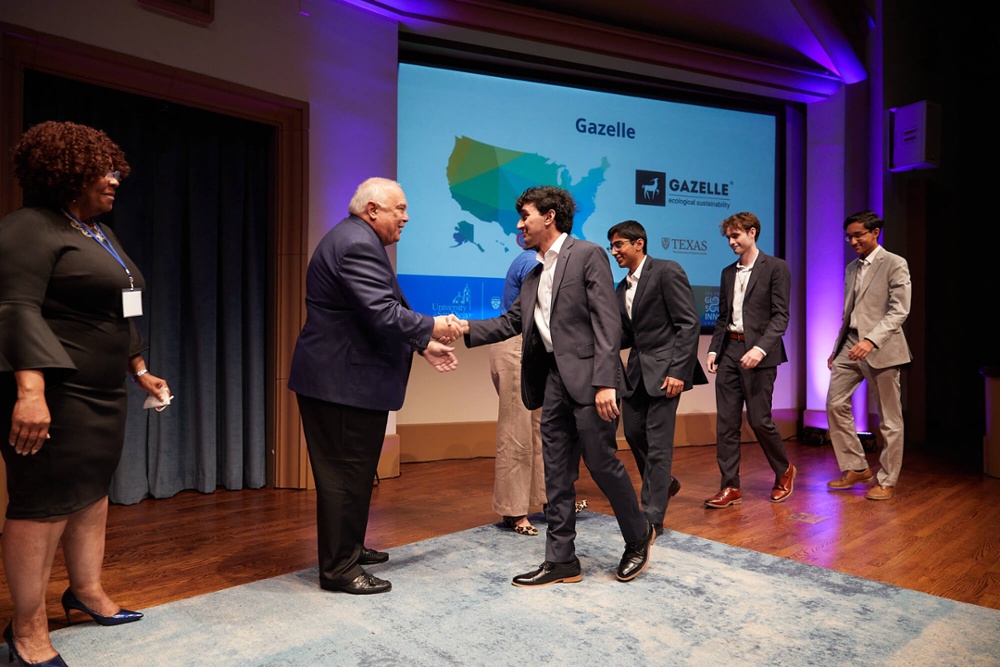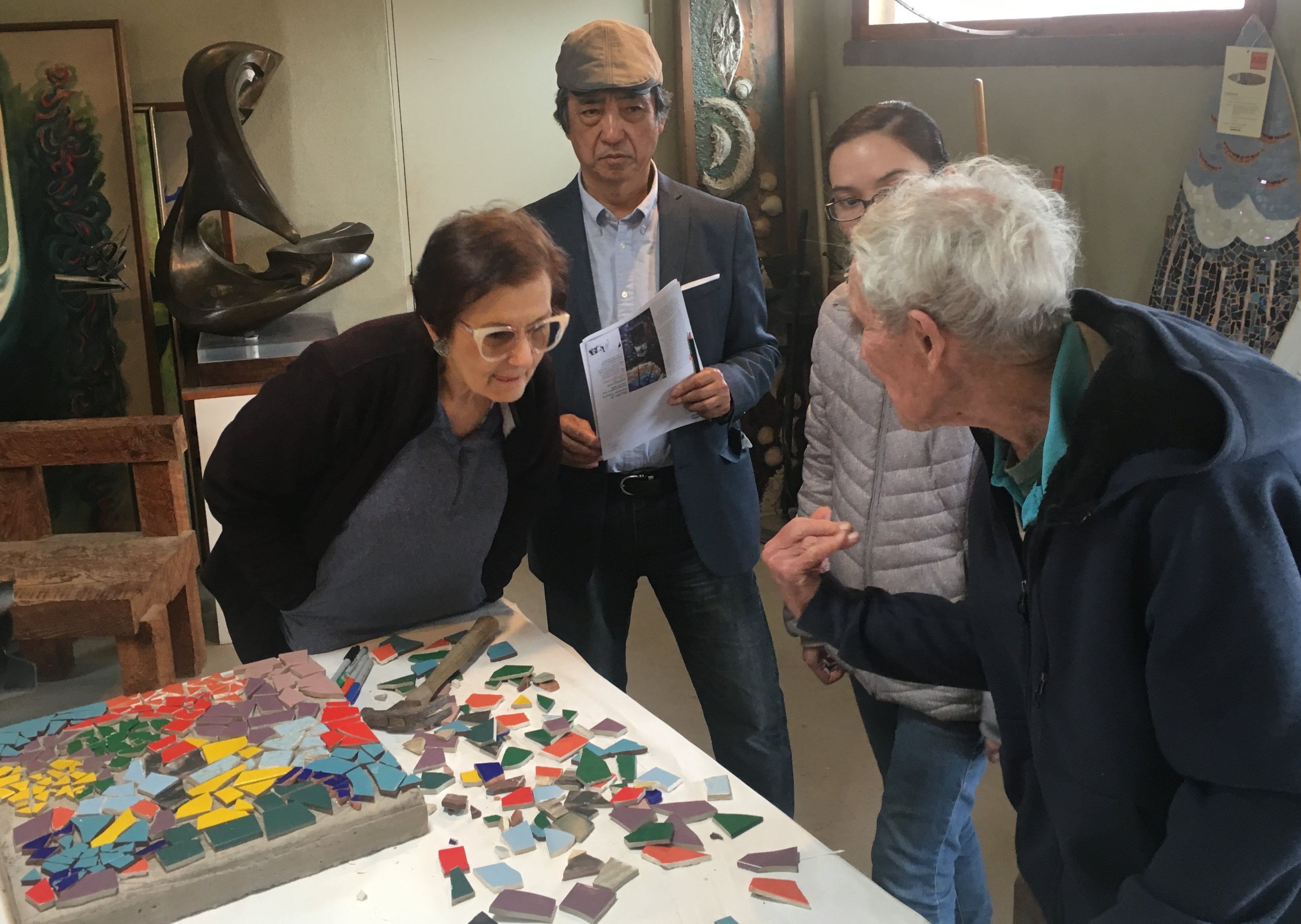How Art and Creativity Strengthen Peacebuilding
begin quote“The artistic five minutes, I have found rather consistently, when it is given space and acknowledged as something far beyond entertainment, accomplishes what most of politics has been unable to attain.” — John Paul Lederach
The following blog post was contributed by Kroc School Professor of Practice Michael Fryer.
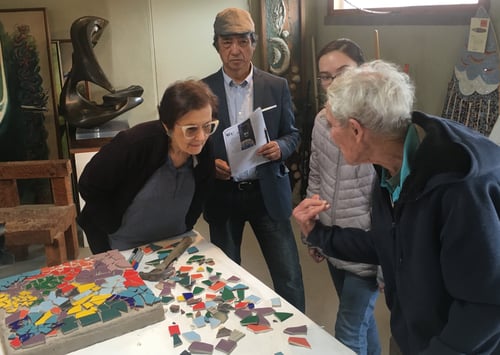
Kroc School Distinguished Professor Necla Tschirgi (left) and Jim Hubbell (right) look at an art project at an event hosted by the Ilan-Lael Foundation.
Jim Hubbell and I were having lunch together in ‘The Chapel’, one of the beautiful, unique structures at his home and studios near where I live in Julian, Calif. “Space matters,” he said.
Those two words resonated deeply with my experience of the value that the arts and creativity play in helping make the world a more peaceful place. Approaching his 88th birthday, Jim is rightly viewed as one of San Diego’s most treasured artists and architects. He sees the world through an artist’s eyes. He notices things most of us miss because artists pay attention. We can learn a lot from him. He and his wife Anne have lived in the mountains since 1958 and their magical spot is now the heart of the Ilan-Lael Foundation, whose mission is to make the world a more peaceful place through encouraging us to tap into our creativity and explore how art can support innovative approaches to solving the world’s problems.
My conversations with Jim and Ilan-Lael’s Executive Director Marianne Gerdes led to a unique collaboration in March 2019, with the Kroc School and Ilan-Lael’s Pacific Rim Parks initiative. One of the parks is on Jeju Island in South Korea and a delegation from Jeju was visiting San Diego. My Kroc School colleagues Distinguished Professor Necla Tschirgi and Associate Professor Topher McDougal along with Professor Farrah Karapetian from USD’s College of Arts and Sciences were part of a group of about 30 people who gathered to explore the role of creativity and peace. I also invited two students, Leah Gage ’19 (MA in Peace and Justice) and Lu Hanessian ’19 (MS in Conflict Management and Resolution) whose work and interests focused on the arts. I facilitated the workshop with Jim Hubbell’s art and poetry helping shape rich conversations that were crafted around peacebuilding concepts.
I’ve been exploring and incorporating creativity and peacebuilding into my work as both a practitioner and teacher for over 20 years. In the late 1990s at The Corrymeela Community in Northern Ireland, I was lucky to work alongside artist Jonny McEwen as he pioneered creative approaches to how the arts were used in peacebuilding in Northern Ireland. Over the years I’ve gotten to know many other creative people working across a broad spectrum of peace and conflict issues.
A few years ago I helped make a short audio documentary called Amman, Baghdad and Cairo: A Musical Ambassador’s ABC.
In July I worked alongside 2018 Master’s in Social Innovation graduate Viet Mai on a project with youth from the Somali Bantu Association of America in City Heights, San Diego. We used the medium of spoken word to explore the themes of rules, borders and limitations.
The role of the arts and creativity is becoming increasingly recognized as not something to be dismissed lightly or marginalized. Within the world of peacebuilding their importance and value have become more deeply rooted. In November 2015 the Kroc School hosted ‘The Art of Peace: Creative Approaches in Conflict Transformation’. In November, we will be hosting ‘Build Peace 2019 – Borderlands: Dividing and Bridging Communities with Technology, Storytelling and the Arts’. John Paul Lederach dedicates a whole chapter in his book ‘The Moral Imagination’ to the role of the arts. He explores the idea that we have placed too much emphasis on the intellectual process of trying to build peace and have “failed to nurture the artist”. Through reconnecting with our inherent creative nature, he reflects, we develop the capacity to become aware of new perspectives and subtle layers of a situation that we normally overlook.
Purely trying to address social change on an intellectual level is destined to fall short. Innovation is rooted in creativity. Examples of how this can have a positive impact on social problems can be found around the world. Antanas Mockus, during his time as Mayor of Bogotá, Colombia, used a variety of innovative initiatives such as hiring 420 mime artists to highlight the dangers of bad driving. Not only were his approaches creative, but they were effective. Faced with the challenge of getting more people to use the stairs in a Stockholm train station, The Fun Theory turned the stairs into a series of working piano keys. People stopped using the escalators because they enjoyed using the stairs more.
At the Kroc School, we’re exploring the complex dynamics of the human experience of conflict and how to respond to them peacefully. We’re supporting students who come to us with the experience of, and interest in, engaging more with arts-based methodologies and practice. In turn, they’re helping to deepen our practice and teaching through sharing what they’ve learned and the questions that have emerged along the way. Here are just a few examples:
- Zoya Sardashti is a current Master’s in Conflict Management and Resolution student whose spent years using theatre to help transform conflict. She’s bringing that expertise to support an initiative with youth in San Diego alongside Kroc Institute for Peace and Justice Program Officer Daniel Orth.
- Master’s in Peace and Justice student Ange Leech, a Fulbright scholar from Australia, has huge experience working with marginalized populations through animation, music and sound production.
- For her capstone, Master’s in Peace and Justice student Jessica Gorman is working with the incoming Women PeaceMakers in a collaboration with Farrah Karapetian and arts students to provide space for reflective practice that encourages resilience and shares learning.
The arts and creativity are not to be dismissed as being unworthy of serious issues. They have a valid and important role in peacebuilding work. Music, drama, art, poetry, dance, etc., can act as a vehicle through which larger issues can be explored. They help open doors to conversations which otherwise might not happen because they can break down the barriers that would otherwise keep them shut. They help give voice to people on the margins, therefore bringing their frustrations, issues, lives, concerns and aspirations to a wider audience.
They can act as moments of defiance and resistance, by refusing to accept that violence and oppression are normal. They help create moments of transcendence that carry the ongoing potential to interrupt patterns of familiarity. The bottom line is that statistics don’t move people. Stories do. Art is how humans tell stories.
When we approach a person in the belief that something creative may emerge from the encounter, it changes everything. When we believe the story of the person we are listening to is worthy of a song, a painting, etc., dynamics shift. Each time we view a situation with an acknowledgment that it carries within it the potential to be crafted into a piece of art, we ensure that we remain open and curious enough to appreciate the value of multi-layered complexity.
Space matters, and artists show us how to look at things in new ways. After the Cedar Fire burned huge swathes of San Diego’s backcountry in 2003, Jim looked over the blackened remains of his home and the area surrounded it. Alongside the understandable tragedy of what was lost was Jim’s artistic fascination and curiosity of being able to see the potential for new growth.
“Even though the Cedar Fire took half of the buildings that we had labored on for 40 years and a great deal of my art, I do not feel myself as if I were a victim. We lived through one of life’s great rhythms, encountering this destructive firestorm. We use the word ‘awful’ to describe such a disaster, which we forget means full of awe. This was a fire to fill us with awe and with a view of the uncontrollable side of life. There is value in the fire, for not only will flowers grow from the ashes, but it brought openness and space.” — Jim Hubbell
Contact:
Justin Prugh
jprugh@sandiego.edu
(619) 260-7573

About the Author
The Joan B. Kroc School of Peace Studies (Kroc School) at the University of San Diego is the global hub for peacebuilding and social innovation. Founded in 2007, the Kroc School equips the next generation of innovative changemakers to shape more peaceful and just societies. We offer master's degrees in peace and justice, social innovation, humanitarian action, conflict management and resolution, and a dual degree in peace and law — programs that have attracted diverse and dynamic students from more than 50 countries. In addition to our graduate programs, the Kroc School is home to the Kroc Institute for Peace and Justice (Kroc IPJ). Founded in 2001, the Institute supports positive change beyond the classroom. Through groundbreaking research, experiential learning, and forward-thinking programs, the Kroc School and Kroc IPJ are shaping a future in which peaceful co-existence is the new normal.


